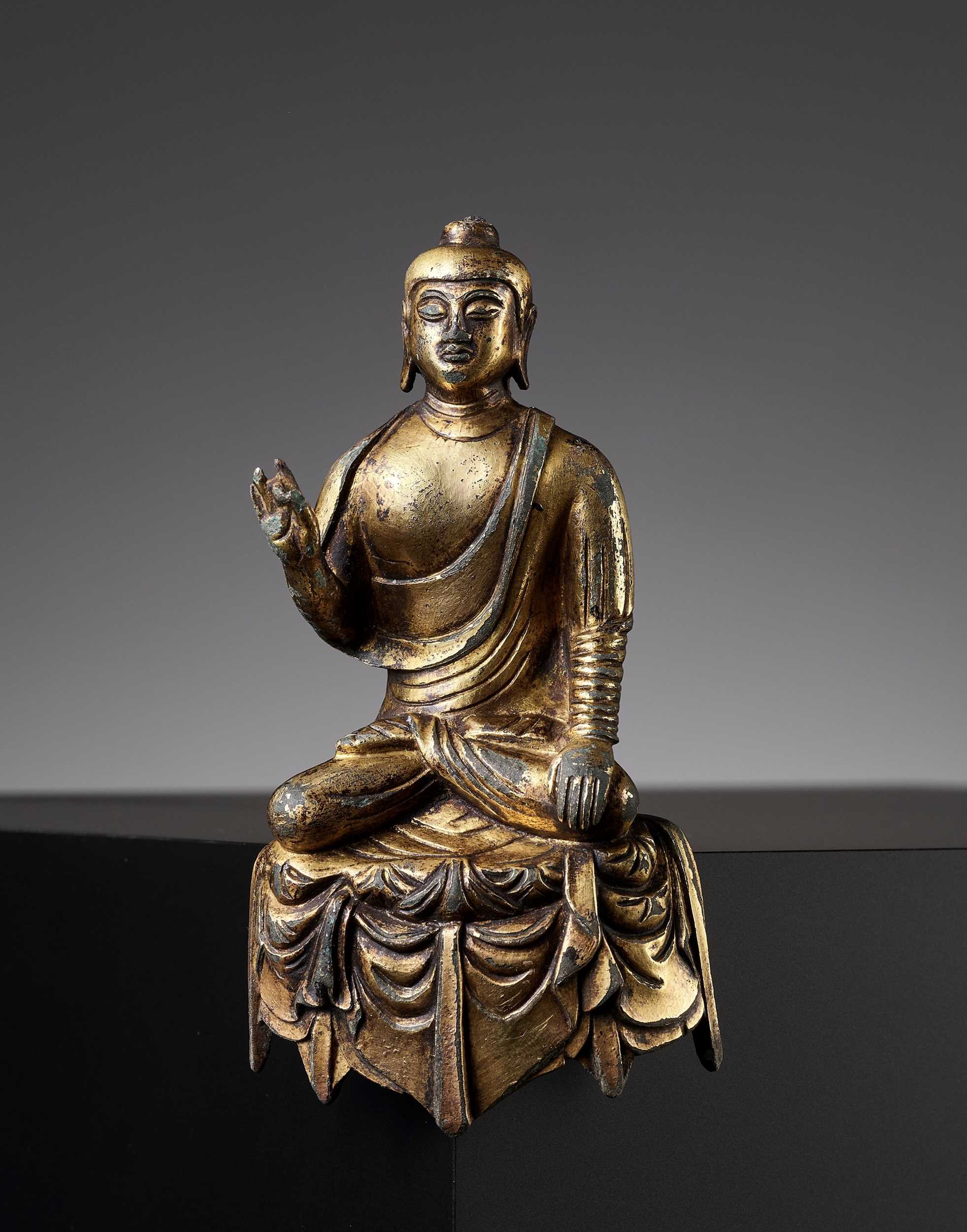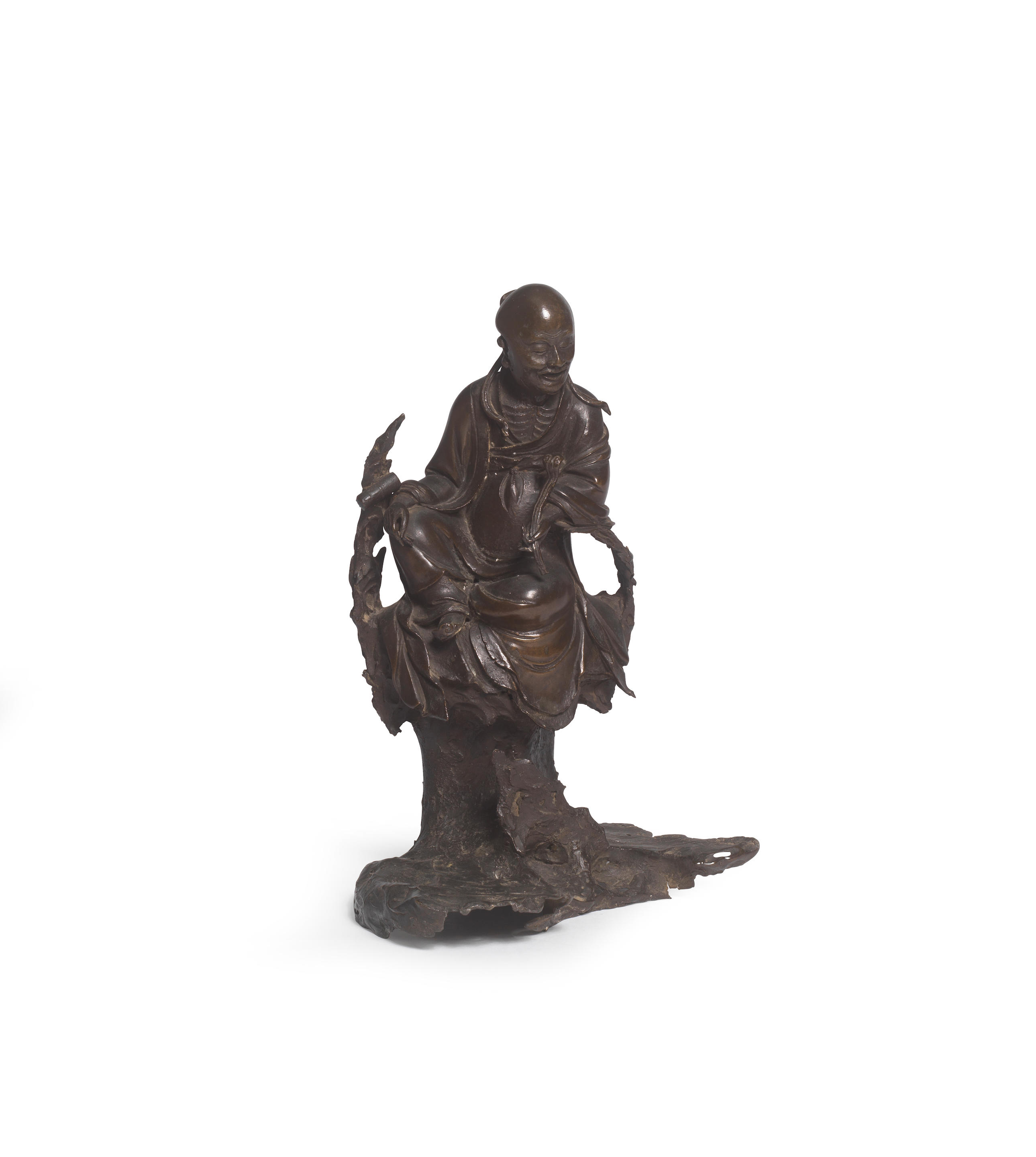Lot details South India, 9th-13th century. Finely cast standing in samabhanga on a tiered circular base incised with lotus petals and raised on a flat square plinth, the lowered left hand holding a kapala, and the right hand raised and clasped around a trident. The voluptuous figure is dressed in a dhoti and adorned with ornaments. Her serene face with a sharp nose, gently pursed lips, and round eyes, all flanked by ears with pendulous earrings. Her hair is tied up and pushed back by a band to the forehead and stands erect as flames of a fire, forming a dramatic halo. The bronze with a naturally grown dark patina with areas of malachite encrustations. Provenance: French trade. Condition: Extensive wear and expected casting irregularities. Signs of weathering, losses, nicks, and scratches. Obvious heat damage from centuries of worship. Overall displaying well. Weight: 2,844.5 g Dimensions: Height 28.2 cm Kali is the fierce form of Uma (Parvati), the female aspect of Shiva. Parvati has her own cycle of myths, and she herself emanates into different forms. Some branches of Hinduism consider the goddess to be the supreme creator divinity herself, who generated all the other gods, including Shiva. Kali is the wrathful form of the goddess generated in the midst of a battle with a demon that the gods failed to conquer. Kali was to drink his blood before any drop fell to ground, or else a new demon would instantly be generated. These demons are metaphors for human vices, such as egotistic pride and arrogance. Literature comparison: Compare a closely related bronze figure of Kali, Chola period, 9th-10th century, in the collection of the Cleveland Museum of Art, accession number 1956.7. Compare a closely related bronze figure of Kali, Chola period, 12th century, in the collection of the Brooklyn Museum, accession number 78.137. Compare a related bronze figure of Kali, Tamil Nadu, South India, 11th century, in the collection of the Norton Simon Museum, accession number M.2010.1.233.S. Auction result comparison: Type: Related Auction: Christie’s New York, 17 September 1999, lot 32 Price: USD 9,200 or approx. EUR 16,000 converted and adjusted for inflation at the time of writing Description: A bronze figure of Shiva Bhairava, South India, Chola dynasty, 13th century Expert remark: Compare the related form and similar casting, modelling of flaming hair, and plinth. Note the smaller size (17.8 cm).
Lot details South India, 9th-13th century. Finely cast standing in samabhanga on a tiered circular base incised with lotus petals and raised on a flat square plinth, the lowered left hand holding a kapala, and the right hand raised and clasped around a trident. The voluptuous figure is dressed in a dhoti and adorned with ornaments. Her serene face with a sharp nose, gently pursed lips, and round eyes, all flanked by ears with pendulous earrings. Her hair is tied up and pushed back by a band to the forehead and stands erect as flames of a fire, forming a dramatic halo. The bronze with a naturally grown dark patina with areas of malachite encrustations. Provenance: French trade. Condition: Extensive wear and expected casting irregularities. Signs of weathering, losses, nicks, and scratches. Obvious heat damage from centuries of worship. Overall displaying well. Weight: 2,844.5 g Dimensions: Height 28.2 cm Kali is the fierce form of Uma (Parvati), the female aspect of Shiva. Parvati has her own cycle of myths, and she herself emanates into different forms. Some branches of Hinduism consider the goddess to be the supreme creator divinity herself, who generated all the other gods, including Shiva. Kali is the wrathful form of the goddess generated in the midst of a battle with a demon that the gods failed to conquer. Kali was to drink his blood before any drop fell to ground, or else a new demon would instantly be generated. These demons are metaphors for human vices, such as egotistic pride and arrogance. Literature comparison: Compare a closely related bronze figure of Kali, Chola period, 9th-10th century, in the collection of the Cleveland Museum of Art, accession number 1956.7. Compare a closely related bronze figure of Kali, Chola period, 12th century, in the collection of the Brooklyn Museum, accession number 78.137. Compare a related bronze figure of Kali, Tamil Nadu, South India, 11th century, in the collection of the Norton Simon Museum, accession number M.2010.1.233.S. Auction result comparison: Type: Related Auction: Christie’s New York, 17 September 1999, lot 32 Price: USD 9,200 or approx. EUR 16,000 converted and adjusted for inflation at the time of writing Description: A bronze figure of Shiva Bhairava, South India, Chola dynasty, 13th century Expert remark: Compare the related form and similar casting, modelling of flaming hair, and plinth. Note the smaller size (17.8 cm).





.jpg?width=1600&quality=70)









Testen Sie LotSearch und seine Premium-Features 7 Tage - ohne Kosten!
Lassen Sie sich automatisch über neue Objekte in kommenden Auktionen benachrichtigen.
Suchauftrag anlegen